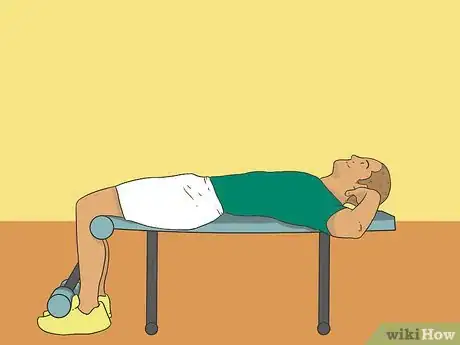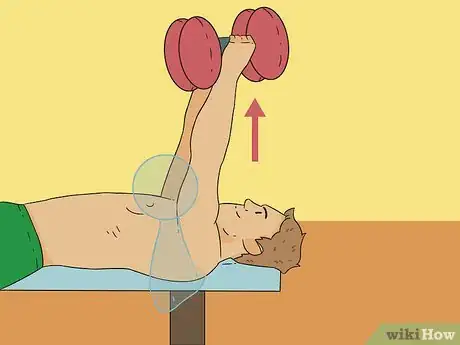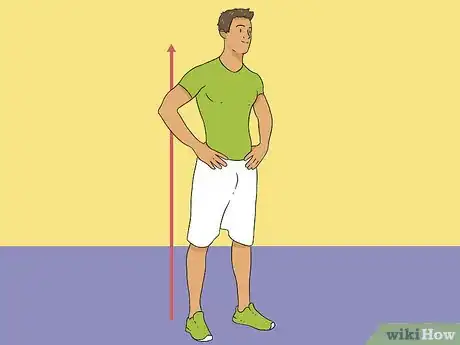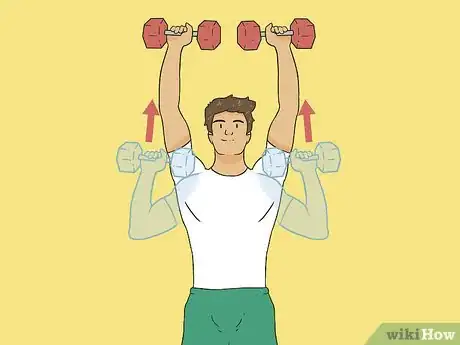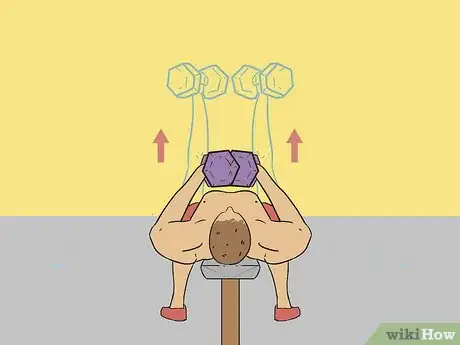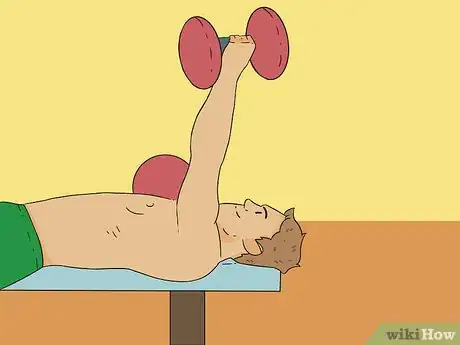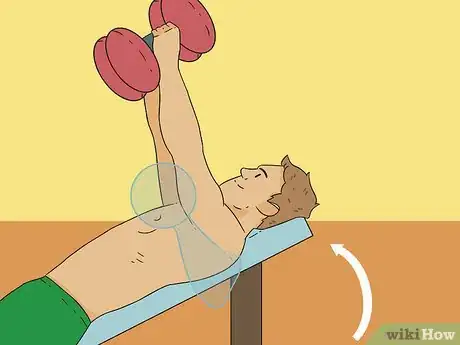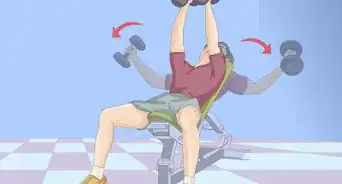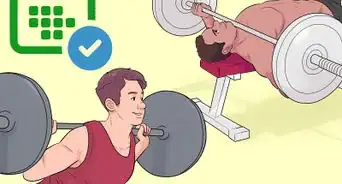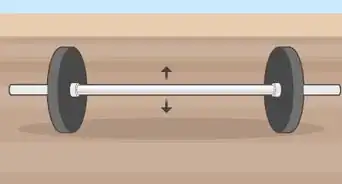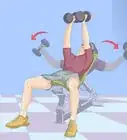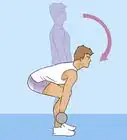This article was co-authored by Michele Dolan and by wikiHow staff writer, Jennifer Mueller, JD. Michele Dolan is a BCRPA certified Personal Trainer in British Columbia. She has been a personal trainer and fitness instructor since 2002.
There are 7 references cited in this article, which can be found at the bottom of the page.
This article has been viewed 43,470 times.
The dumbbell press allows you to specifically target chest muscles, giving you greater strength and definition. Because you have to balance the dumbbells individually, it also contributes to strong core development. You can do dumbbell presses on a standard flat weight bench or overhead while standing. Variations of the dumbbell press add depth to your workout routine.
Steps
Using a Bench
-
1Lie on a flat bench. Lie on your back on a flat weight bench with your legs at either side. Your knees should be at right angles with your feet flat on the floor. Adjust your lower back so that your spine is neutral, your shoulder blades pressed down on either side of your spine.
- Hold the dumbbells on your thighs to start. If this is your first time doing this exercise, use fairly light weights to start.
- As you move to heavier weights, get a friend to spot you. Instead of resting the weights on your thighs to start, have your friend hand you the weights once you get into position.
-
2Raise the dumbbells to your sides. Lift the dumbbells one at a time and hold them in front of your body at shoulder-width, just to the sides of your chest. Your elbows should be at right angles with your forearms perpendicular to your body. This is the starting position for the exercise.[1]
- Maintain control of the weight. If the dumbbell is shaky or wobbly and you have difficulty controlling it, go with a lighter weight.
Advertisement -
3Press the dumbbells up as you exhale. Extend your arms and press the dumbbells straight up, using your chest muscles. When your arms are fully extended, straighten your elbows and squeeze your chest muscles so that the ends of the dumbbells are touching each other.[2]
- Squeeze and hold at the top of the press for a second before lowering the weights back down.
-
4Lower the dumbbells slowly on an inhale. Lower the weights back to the starting position, so that your elbows are at a 90-degree angle. Move slowly, taking about twice as long to lower the weights as you did to press them.
- With proper form, you should feel your chest muscles doing most of the work. If you feel strain in your shoulders, stop and check your form. Make sure your shoulder blades are tucked in along the length of your spine and your shoulders are flat, not crunched.
- Be particularly careful not to lower the weights too far. This can cause shoulder injuries, including torn tendons and ligaments.
-
5Repeat as necessary for your training goals. The number of dumbbell presses you do will depend on whether you're training for muscle growth, strength, or endurance. Generally, do higher reps with lighter weights for endurance. Do lower reps with heavier weights for strength.[3]
- For example, if you're training for increased muscle strength, you might do 1 to 5 reps of the largest weight you can press for that number of reps.
- If you're training for overall toning and fitness, use a lighter weight and do 10-15 reps.
Performing Standing Dumbbell Presses
-
1Start in a standing position. For the standing dumbbell press, start with your back neutral and your feet about shoulder-width apart. You can lock your knees, or keep them slightly bent. Activate your glutes and core.[4]
- Check that your back is neutral and that you aren't hunching over or leaning back. Open your shoulders so that your shoulder blades are tucked in, falling on either side of your spine.
-
2Hold the dumbbells at your shoulders. Use an overhand grip, so that your knuckles are facing up and your palms are towards your body. Your elbows should be pressed along your sides so that the dumbbells are directly in front of your shoulders.[5]
- From the starting position, take a deep breath. Draw your awareness to your body, making sure your back is straight and you're not leaning back or hunching over.
-
3Raise the dumbbells overhead on an exhale. Allow your movement to follow your breath, keeping your lift slow and controlled. Avoid jerking the weight upward, which can strain your elbows. Rotate your arms as you lift, so that at the top of the lift your palms will be facing forward, away from you.[6]
- Gently straighten your elbows at the top of the lift. Pause and press upward.
- Make sure you have control over the weight. Go with a lighter weight if your wrists are wobbly.
-
4Lower the dumbbells as you inhale. Return the dumbbells to your starting position in a slow, controlled movement. Keep your arms close to your body. Avoid flaring out your elbows, which can put too much strain on your wrists.[7]
- Rotate your arms as you lower the dumbbells, so that you return to your starting position with your palms facing your body.
-
5Complete your desired number of repetitions. Do more reps with lighter weights if you're training for muscle endurance, and fewer reps with heavier weights if you're training for muscle growth and strength.[8]
- Make sure you're not using a heavier weight than you can control. If your arms or wrists are shaking, or if the weight is wobbly, decrease the weight.
- If you're using heavier dumbbells, always have a spotter when lifting overhead. You don't want to risk dropping the weight on your head or shoulder.
Adding Variations
-
1Do the overhead press while seated for extra support. Sit on the end of a weight bench with your feet on either side of the bench. Your feet should be flat on the floor with your knees at right angles. Do the overhead press as usual.[9]
- This variation is a good option if you have a recent back injury or chronic back problems. It can also help you perfect your form if you are just getting started with weight training.
-
2Maximize pectoral growth with the squeeze press. Lie on your back and extend your arms as you would doing a dumbbell bench press, holding the dumbbells together with your palms facing each other. Instead of lowering the weights, keep the weights together and press them together as hard as you can, squeezing your chest muscles.[10]
- This exercise may look strange, but it activates your chest, forcing your pectoral muscles to do all the work. If you're interested in growing or strengthening your pecs, add this variation to your routine.
- For this exercise to work, squeeze the dumbbells together as hard as you can. It's best to use hexagon-shaped dumbbells, which will be easier on your wrists.
-
3Alternate arms for better control. Alternating arms allows you to build strength and flexibility in your shoulders. As you lift one weight, keep the other at starting position. When you bring the weight down on one side, lift the other up.[11]
- If you're alternating arms, resist the urge to use heavier weights. You run the risk of straining your muscles.
-
4Raise the bench 45 degrees to target your upper chest muscles. Complete the same motion as you would for a regular dumbbell bench press, but raise the bench instead of leaving it flat. The angle forces your upper chest muscles to adapt and work harder.[12]
- You can also lower the bench to a 45-degree decline to target your lower chest muscles just as you targeted your upper chest muscles with the incline dumbbell bench press.
- If you've been doing dumbbell bench presses and want to add this variation, start with a lighter weight than you normally use for a flat dumbbell bench press. You're using different muscles in different ways, so you need to build them up first.
Warnings
- Barbell presses may look like they're safer than free weights, but this is not necessarily so. Use a spotter if you're lifting heavier dumbbells, or if there's a risk the dumbbell could fall in your face.[13]⧼thumbs_response⧽
- If you're just getting started with weight training, talk to your doctor. They can make sure you're healthy enough to begin a weight training program and let you know about any problems you might face.⧼thumbs_response⧽
References
- ↑ https://www.bodybuilding.com/exercises/dumbbell-bench-press
- ↑ https://www.bodybuilding.com/exercises/dumbbell-bench-press
- ↑ https://www.bodybuilding.com/fun/how-many-reps-should-you-do.html
- ↑ https://www.builtlean.com/2017/05/10/standing-dumbbell-press/
- ↑ https://www.verywellfit.com/how-to-do-the-dumbbell-overhead-press-3498298
- ↑ https://www.builtlean.com/2017/05/10/standing-dumbbell-press/
- ↑ https://www.builtlean.com/2017/05/10/standing-dumbbell-press/
- ↑ https://www.bodybuilding.com/fun/how-many-reps-should-you-do.html
- ↑ https://www.verywellfit.com/how-to-do-the-dumbbell-overhead-press-3498298
